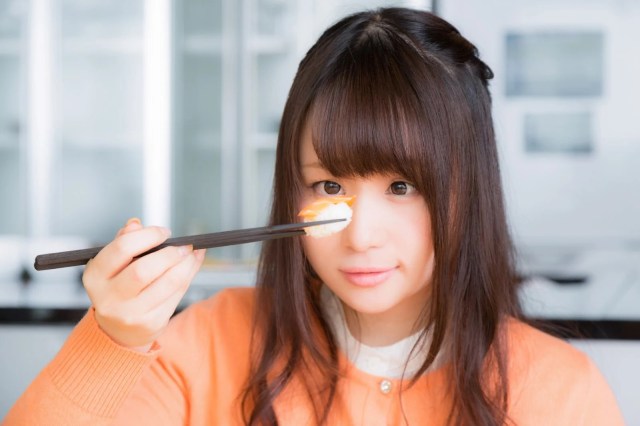
Kaitenzushi, or conveyor belt sushi restaurants, are one of Japan’s most famous contributions to the dining world. The concept is simple: customers sit around a revolving conveyor belt packed with different sushi dishes, and take the plates they like as they roll by. But now in Japan there’s a new trend that’s threatening to put the brakes on the traditional conveyor belt system. It seems that Japanese customers no longer want to take any dishes off the conveyor belt, instead opting to use it as a giant, revolving display case. Customers are now pointing at the perfectly edible sushi as if they are plastic sushi replicas and ordering them with the wait staff.
The new trend seems to be influenced by the hugely popular touch panel ordering system offered by a number of kaitenzushi chains in recent years. Touch panels installed at dining booths let customers scroll through a variety of sushi options, and even keep track of the bill throughout the meal. An added upside to the fun system is the knowledge that the order goes straight to the sushi chef who then whips up the sushi, guaranteeing minimal time between the chef’s skilled hands and the customer’s demanding taste buds.
This digital tweak to the almost 60-year-old kaitenzushi tradition is now affecting conveyor belt sushi restaurants all around Japan. In a country where customer satisfaction is paramount, business owners without touch panel screens are accommodating orders for freshly made sushi with the odd, but workable point-at-the-sushi-train ordering system. Customers who want a fresh order simply look at the plates going round, call the wait staff over, then point at the ones they like and ask for them to be prepared. This type of ordering was unheard of until only recently, but now in Tokyo this practice has become so common that many wait staff don’t even blink an eye to it anymore.
Young university types, middle-aged men and women, and mothers with children have all been seen ordering this way. Maruha Nichiro Corporation, a Japanese seafood company, confirmed the recent move away from traditional kaitenzushi ordering habits when they surveyed 1,000 customers about their preferences. The respondents, all men and women who visit these types of restaurants once a month or more, were asked whether they mostly take plates from the revolving belt or if they place their sushi orders with wait staff. They found that 61.1 percent mostly order with the wait staff.
With customers preferring freshness over speed, the future of kaitenzushi remains unknown. Already, some restaurants in Japan have thrown away their oval-shaped conveyor belts and refitted their shops with touch screens and special three-tiered “high speed transport lanes” in an effort to make the customers’ fresh orders appear before their very eyes. Who knows what exciting innovations this new generation of customers will inspire? One thing is certain though; they’ll soon be rewriting the guidebooks when it comes to visiting kaitenzushi restaurants in Japan.
Sources: J-cast via Livedoor News
Featured image: Pakutaso
● Want to hear about SoraNews24’s latest articles as soon as they’re published? Follow us on Facebook and Twitter!

 Conveyor belt sushi chain taking the bold, eco-friendly step of getting rid of all its conveyors
Conveyor belt sushi chain taking the bold, eco-friendly step of getting rid of all its conveyors Japanese revolving sushi restaurant chain stops revolving during coronavirus outbreak
Japanese revolving sushi restaurant chain stops revolving during coronavirus outbreak Will virtual plate procession become the new normal for conveyor belt sushi restaurants in Japan?
Will virtual plate procession become the new normal for conveyor belt sushi restaurants in Japan? Revolving sushi chain Choshimaru’s sushi will no longer revolve in response to “sushi terrorism”
Revolving sushi chain Choshimaru’s sushi will no longer revolve in response to “sushi terrorism” This restaurant’s US$0.45 sushi is an amazing way to expand your sushi horizons in Tokyo
This restaurant’s US$0.45 sushi is an amazing way to expand your sushi horizons in Tokyo Red light district sushi restaurant in Tokyo shows us just how wrong we were about it
Red light district sushi restaurant in Tokyo shows us just how wrong we were about it Sandwiches fit for a sumo served up in Osaka【Taste Test】
Sandwiches fit for a sumo served up in Osaka【Taste Test】 Pokémon Sleep camping suite and guestrooms coming to Tokyo Hyatt along with giant Snorlax burgers
Pokémon Sleep camping suite and guestrooms coming to Tokyo Hyatt along with giant Snorlax burgers Tokyo Tsukiji fish market site to be redeveloped with 50,000-seat stadium, hotel, shopping center
Tokyo Tsukiji fish market site to be redeveloped with 50,000-seat stadium, hotel, shopping center Beautiful Red and Blue Star luxury trains set to be Japan’s new Hokkaido travel stars
Beautiful Red and Blue Star luxury trains set to be Japan’s new Hokkaido travel stars Akihabara pop-up shop sells goods made by Japanese prison inmates
Akihabara pop-up shop sells goods made by Japanese prison inmates French Fries Bread in Tokyo’s Shibuya becomes a hit on social media
French Fries Bread in Tokyo’s Shibuya becomes a hit on social media McDonald’s new Happy Meals offer up cute and practical Sanrio lifestyle goods
McDonald’s new Happy Meals offer up cute and practical Sanrio lifestyle goods Wendy’s releases a Pretzel Roast Beef Burger aimed at foreign tourists in Japan
Wendy’s releases a Pretzel Roast Beef Burger aimed at foreign tourists in Japan Starbucks Japan adds a Motto Frappuccino to the menu for a limited time
Starbucks Japan adds a Motto Frappuccino to the menu for a limited time All-you-can-drink Starbucks and amazing views part of Tokyo’s new 170 meter-high sky lounge
All-you-can-drink Starbucks and amazing views part of Tokyo’s new 170 meter-high sky lounge More foreign tourists than ever before in history visited Japan last month
More foreign tourists than ever before in history visited Japan last month Japanese ramen restaurants under pressure from new yen banknotes
Japanese ramen restaurants under pressure from new yen banknotes Studio Ghibli releases new action figures featuring Nausicaä of the Valley of the Wind characters
Studio Ghibli releases new action figures featuring Nausicaä of the Valley of the Wind characters New private rooms on Tokaido Shinkansen change the way we travel from Tokyo to Kyoto
New private rooms on Tokaido Shinkansen change the way we travel from Tokyo to Kyoto Starbucks reopens at Shibuya Scramble Crossing with new look and design concept
Starbucks reopens at Shibuya Scramble Crossing with new look and design concept Studio Ghibli glasses cases let anime characters keep an eye on your spectacles
Studio Ghibli glasses cases let anime characters keep an eye on your spectacles Beautiful Ghibli sealing wax kits let you create accessories and elegant letter decorations【Pics】
Beautiful Ghibli sealing wax kits let you create accessories and elegant letter decorations【Pics】 Studio Ghibli releases Kiki’s Delivery Service chocolate cake pouches in Japan
Studio Ghibli releases Kiki’s Delivery Service chocolate cake pouches in Japan New definition of “Japanese whiskey” goes into effect to prevent fakes from fooling overseas buyers
New definition of “Japanese whiskey” goes into effect to prevent fakes from fooling overseas buyers Our Japanese reporter visits Costco in the U.S., finds super American and very Japanese things
Our Japanese reporter visits Costco in the U.S., finds super American and very Japanese things Studio Ghibli unveils Mother’s Day gift set that captures the love in My Neighbour Totoro
Studio Ghibli unveils Mother’s Day gift set that captures the love in My Neighbour Totoro New Japanese KitKat flavour stars Sanrio characters, including Hello Kitty
New Japanese KitKat flavour stars Sanrio characters, including Hello Kitty New Pokémon cakes let you eat your way through Pikachu and all the Eevee evolutions
New Pokémon cakes let you eat your way through Pikachu and all the Eevee evolutions Disney princesses get official manga makeovers for Manga Princess Cafe opening in Tokyo
Disney princesses get official manga makeovers for Manga Princess Cafe opening in Tokyo Sales of Japan’s most convenient train ticket/shopping payment cards suspended indefinitely
Sales of Japan’s most convenient train ticket/shopping payment cards suspended indefinitely Sold-out Studio Ghibli desktop humidifiers are back so Totoro can help you through the dry season
Sold-out Studio Ghibli desktop humidifiers are back so Totoro can help you through the dry season Japanese government to make first change to romanization spelling rules since the 1950s
Japanese government to make first change to romanization spelling rules since the 1950s Ghibli founders Toshio Suzuki and Hayao Miyazaki contribute to Japanese whisky Totoro label design
Ghibli founders Toshio Suzuki and Hayao Miyazaki contribute to Japanese whisky Totoro label design Doraemon found buried at sea as scene from 1993 anime becomes real life【Photos】
Doraemon found buried at sea as scene from 1993 anime becomes real life【Photos】 Tokyo’s most famous Starbucks is closed
Tokyo’s most famous Starbucks is closed One Piece characters’ nationalities revealed, but fans have mixed opinions
One Piece characters’ nationalities revealed, but fans have mixed opinions We asked a Uniqlo employee what four things we should buy and their suggestions didn’t disappoint
We asked a Uniqlo employee what four things we should buy and their suggestions didn’t disappoint Princesses, fruits, and blacksmiths: Study reveals the 30 most unusual family names in Japan
Princesses, fruits, and blacksmiths: Study reveals the 30 most unusual family names in Japan Kappa Sushi rents out conveyor belt for diners to use at home
Kappa Sushi rents out conveyor belt for diners to use at home Japan’s Sushiro revolving sushi chain stops revolving with conveyor-less food court branch
Japan’s Sushiro revolving sushi chain stops revolving with conveyor-less food court branch Sharpen your sushi-selecting skills with the High Speed Sushi-Go-Round Quiz! 【Videos】
Sharpen your sushi-selecting skills with the High Speed Sushi-Go-Round Quiz! 【Videos】 Survey reveals the top 10 worst behaviors to have while on a conveyor-belt sushi date
Survey reveals the top 10 worst behaviors to have while on a conveyor-belt sushi date Mr. Sato has time-travelled to the year 3030 with impressive sushi technology
Mr. Sato has time-travelled to the year 3030 with impressive sushi technology Put down the soy sauce! We try a new “expert” way to season your sushi【Taste test】
Put down the soy sauce! We try a new “expert” way to season your sushi【Taste test】 Japan’s first-ever wanko soba conveyor belt restaurant opens in Tokyo
Japan’s first-ever wanko soba conveyor belt restaurant opens in Tokyo Which Japanese conveyor belt sushi chain has the best tuna sushi?【Taste test】
Which Japanese conveyor belt sushi chain has the best tuna sushi?【Taste test】 Sushi-delivering robots to go into operation in Japan next month
Sushi-delivering robots to go into operation in Japan next month Sushi tacos now on sale in Japan — Can this cross-cultural cuisine please our biggest taco fan?
Sushi tacos now on sale in Japan — Can this cross-cultural cuisine please our biggest taco fan? We try vegetarian sushi at Tokyo’s newest sushi train restaurant 【Pics & Taste Test】
We try vegetarian sushi at Tokyo’s newest sushi train restaurant 【Pics & Taste Test】 Can’t go to conveyor belt sushi? Major Japanese chain will bring the conveyor belt to you!
Can’t go to conveyor belt sushi? Major Japanese chain will bring the conveyor belt to you! Mr. Sato tries out Kappa Sushi’s salmon salad mountain, a fun dish available for only one week
Mr. Sato tries out Kappa Sushi’s salmon salad mountain, a fun dish available for only one week Japanese restaurant serves up the biggest sushi we’ve ever seen!
Japanese restaurant serves up the biggest sushi we’ve ever seen! Is it gross to eat sushi that the chef pressed with his bare hands?【Survey】
Is it gross to eat sushi that the chef pressed with his bare hands?【Survey】
Leave a Reply